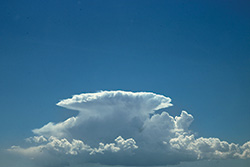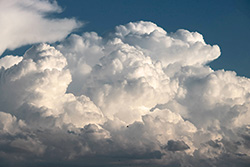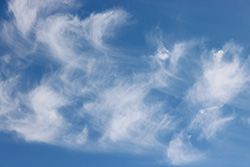 July is often the start of the “monsoon season” in Moab, even though the annual average rainfall for the month is about one inch. High summer temperatures lend to the build-up of afternoon cumulonimbus or thunderhead clouds. These spectacular thunderheads may shower the land with blessed rain, or not – sometimes the rain, called virga, evaporates before touching the ground. Thunder and lightning often accompany these storms, so outdoor enthusiasts should be aware and know when to seek shelter.
July is often the start of the “monsoon season” in Moab, even though the annual average rainfall for the month is about one inch. High summer temperatures lend to the build-up of afternoon cumulonimbus or thunderhead clouds. These spectacular thunderheads may shower the land with blessed rain, or not – sometimes the rain, called virga, evaporates before touching the ground. Thunder and lightning often accompany these storms, so outdoor enthusiasts should be aware and know when to seek shelter.
Fourth-century B.C. Greek dramatist Aristophanes said, “Clouds are the patron goddesses of idle fellows.” Wispy, ephemeral, scattered – these are the traits that make daydreamers and cloud spotters so interested in clouds.
For London pharmaceutical manufacturer and amateur meteorologist Luke Howard (1772-1864), watching clouds was more than just a daydreamer’s pastime. For years, Howard observed cloud formations and the weather patterns that either preceded or followed various cloud types. He understood that although clouds came in many different shapes, they tended to appear in a limited number of forms which could also change forms quickly.
 To better communicate about clouds, Howard introduced a nomenclature, based on Latin names, that defined basic forms of clouds, such as cirrus (meaning “tail or wisp “), cumulus (meaning “heap or pile”), and stratus (meaning “layer or sheet’). Howard also observed that intermediate types of clouds formed from these basic ones so he added more names such as cirrostratus and cumulonimbus to identify these intermediate forms. Howard presented his idea, Essay on the Modification of Clouds, in 1802 to an esteemed group of science debaters called the Askesian Society. His naming system still exists today but in a more detailed format.
To better communicate about clouds, Howard introduced a nomenclature, based on Latin names, that defined basic forms of clouds, such as cirrus (meaning “tail or wisp “), cumulus (meaning “heap or pile”), and stratus (meaning “layer or sheet’). Howard also observed that intermediate types of clouds formed from these basic ones so he added more names such as cirrostratus and cumulonimbus to identify these intermediate forms. Howard presented his idea, Essay on the Modification of Clouds, in 1802 to an esteemed group of science debaters called the Askesian Society. His naming system still exists today but in a more detailed format.
Though there are various meteorological organizations that study clouds (known as nephology), climate change, and weather patterns including the U.S. Weather Bureau and World Meteorological Organization, the latter governs the naming of clouds and publishes an International Cloud Atlas that defines cloud types. In 2009, the Cloud Appreciation Society (Yes, such a group exists!) proposed adding another cloud type called “asperatus” to the list. In Latin, asperatus means “roughness” which defines these dark, stormy-looking clouds which resemble a sea of dark waves. Included in a supplement to the atlas in 2017, these were the first new cloud types to be added in over 50 years.
 From Howard’s observations of clouds and weather, the science of meteorology blossomed. Even in the early 1800s, the science of weather prediction was in its infancy. Even the reasons behind cloud formation weren’t well known. Today, we know that clouds are signs that indicate weather changes in the atmosphere; they are the visual clues of an invisible process.
From Howard’s observations of clouds and weather, the science of meteorology blossomed. Even in the early 1800s, the science of weather prediction was in its infancy. Even the reasons behind cloud formation weren’t well known. Today, we know that clouds are signs that indicate weather changes in the atmosphere; they are the visual clues of an invisible process.
One of the additions to Howard’s classification system in 1880 was the cumulonimbus cloud – the type observed during the summer months in the Canyonlands area that tower over the landscape, bearing the chance of rain. Cumulonimbus was the ninth cloud type to be added to the cloud naming system and is probably where the phrase, “On top of cloud nine,” which refers to someone feeling good and on top of the world, originated from.
Though these cumulonimbus form exciting cloudscapes, they may unleash lightning and torrential rains. Although the desert absorbs some of this rainfall, much of it runs off the slickrock and cascades down canyon walls and washes. Flash floods are not uncommon and one best be on the lookout for these raging rivers after a good storm.